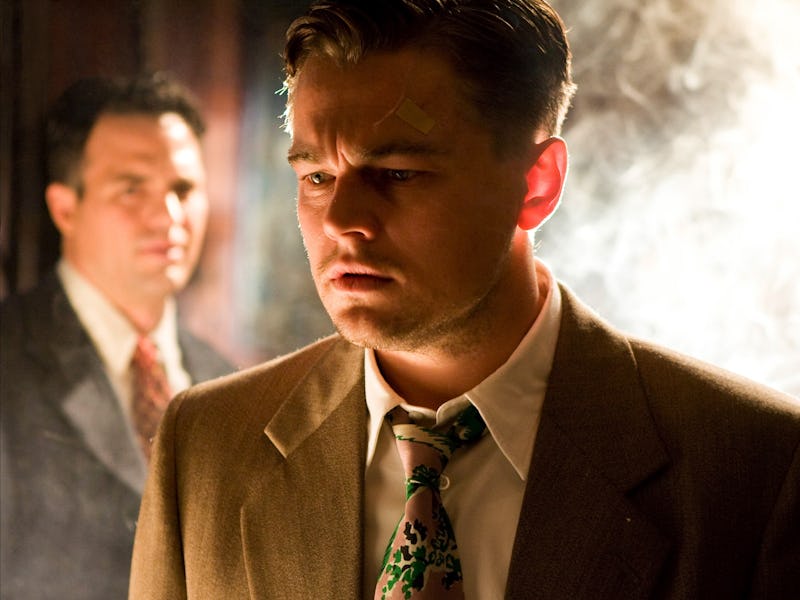Shutter Island’s Ending Continues To Haunt, 15 Years On
“Which would be worse — to live as a monster, or to die as a good man?”

A thick blanket of fog covers the first frames of Shutter Island, an easy metaphor for the case US Marshal Teddy Daniels (Leonardo DiCaprio) thinks he’s investigating: shrouded in secrecy, and impossible to see his way through. By the end, that fog will have cleared, and the truth will have descended on him with a terrible, shattering clarity. The film will be recontextualised, from thriller to tragedy. And a single line of dialogue — a flash of a question that wounds Teddy in the moment — will endure, haunting audiences 15 years after its release.
Like the 2003 Dennis Lehane novel it’s based on, Martin Scorsese’s propulsive adaptation is also set in 1954. Rachel Solando, one of the patients at Ashecliffe — a psychiatric institution for the criminally insane — is reported to have broken out of a locked room and seemingly vanished off the eponymous island. Teddy and his new partner Chuck (Mark Ruffalo) arrive and begin making inquiries, but find that the doctors are uncooperative, access to one ward has been strictly cut off, and the patients appear to be hiding something. Over the film, Teddy becomes increasingly paranoid that the institution is a front for a more sinister experimental facility, while also struggling with hallucinations of his late wife, Dolores (Michelle Williams), and disquieting memories of his role in the liberation of Dachau. It’s gradually revealed that his interest in the case is also personal — he believes that Andrew Laeddis, the man he suspects of having murdered Dolores, is on the island.
Shutter Island’s big twist, one that makes it all the more rewarding on subsequent rewatches, is that Teddy is Andrew Laeddis. He hasn’t just arrived at the island, but been a patient there for the past two years. He murdered Dolores, after she killed their three children in a fit of manic depression. Unable to cope with the reality of having failed his family, he recasts himself as the savior figure in his fantasy, now deep into his delusion of being Teddy. The missing person’s case is actually an elaborate role-playing exercise, crafted by his doctors and aimed at getting through to him. “Chuck” is his primary physician, Dr. Sheehan, who accepted the role to stay close to Andrew and keep him safe. If the game doesn’t help him regain lucidity, they’ll have no choice but to lobotomize him. His propensity for violence makes him too much of a risk otherwise.
The twist casts old suspicions in a new light — “Teddy” intuits that all of the patients have been coached to say they’ve never seen Laeddis and they have, but only because he needed to arrive at the revelation of who this man is himself. And he does by the end, displaying a crushing awareness of his true identity and accepting culpability.
In the very next scene, however, he relapses into his “Teddy” persona, indicating to Dr. Sheehan that he’s plotting an escape. Andrew’s breakthrough was short-lived. Delusion has taken hold of him once more. A lobotomy is imminent. It’s a somber ending, but the film’s final-line twist is even more of a gut punch. “Which would be worse — to live as a monster, or to die as a good man?” asks Andrew, getting up and walking willingly towards the orderlies approaching him, even as Dr. Sheehan bolts upright too. Realization strikes him at the same time as it does the audience — this is no longer a mentally ill man scheduled for a lobotomy, but a sane one actively choosing the procedure so he can repress his guilt and grief. He’s no longer “Teddy,” needing to be reminded he’s Andrew, but Andrew, pretending to be Teddy so he can forget.
Teddy confronts a ghost.
Throughout the movie, Andrew has questioned what’s real and what’s not, what information he can take at face value and who he can trust. Throughout, the one thing he’s remained convinced of is his own sanity, the steadfast belief that anyone trying to persuade him otherwise was a liar. Now, faced with all his moral failings, it’s he who turns to a lie. His elaborate illusion was a temporary reprieve from the pain. Now he seeks a more permanent solution.
Over the movie, several patients tell “Teddy” that they’d rather be confined here than ever leave; they’re too afraid of what the real world must be like now, too wracked by doubt about their capacity to deal with it. Andrew too retreats into the safety of his fictional world, too broken to break out of it. “Sanity’s not a choice,” a psychiatrist (Ben Kingsley) tells “Teddy” at one point. “You can’t just choose to get over it.” But a choice dangles in front of Andrew, and he grasps at it.
“I think he has a momentary flash,” said Lehane in an interview, putting to rest the various interpretations of the film’s ending. “It’s just one moment of sanity mixed in the midst of all the other delusions.” A brief moment is all it takes. Andrew, plagued by repeated visions of fire, finally takes a match to his past, erasing his old self, and giving the film an abiding afterlife in the process.